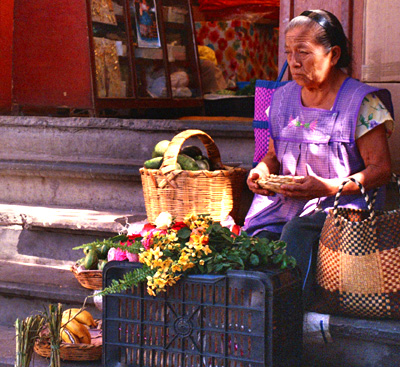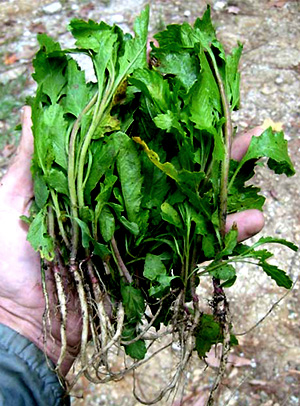
Traditional herbs, flowers and more sold on the steps of a market in the community of Villa de Etla, Oaxaca state; copyright free image courtesy of "Elattina" made available through Wikimedia Commons.
These are the most interesting ones, sold like those seen at the right. You may need some Spanish, a real interest in traditional herbs used for seasoning, and a cultural sensitivity with your questioning, but if you're lucky, you may discover some extraordinary tastes hard to find elsewhere.
This is basil, Ocimum basilicum of the mint family. According to Mexicans, comes in two sorts. The macho, or male, type is purple and stronger smelling than the hiembra, or female, type.

Nowadays most North Americans refer to the plant shown at the left by its Spanish name, cilantro, but Europeans often call it coriander. By whatever name, it's surely the best-loved herb of Mexican cuisine, finding its way into most stews and salads. This is another of those herbs originally from southern Europe but now thoroughly Mexicanized. This herb, Coriandrum sativum of the Parsley Family, grows three feet high or so, though many perfectionists insist that the most tasty cilantro is provided by young plants not over a foot high.

In the English-speaking world often it's called Mexican tea, though in the US the Mexica name is gaining foothold. In Mexico it's the main herb seasoning for bean soup, and much used in stews, tamales, quesadillas and more; however, the flavor compounds in strong-smelling epazot break down under sustained heating, so the herb is added near he end of cooking. Epazote is a member of the Amaranth/goosefoot Family. Besides being a flavorful condiment, Mexicans say it cuts down on flatulence caused by the beans. Also it's much used medicinally against intestinal worms.

We don't have an English name for this leaf, seen at the left. The words hoja santatranslate literally to "blessed leaf," surely because of their strong minty, anise-like flavor. The leaf comes from the small, native Mexican tree Piper auritum of the Black-Pepper family -- black pepper of salt-and-pepper fame. In hot, humid lowland Mexico where Hoja santa grows, leaves often are wrapped around tamales to impart their anise-like flavor. When the wrapped tamales are cooked, the soft leaves merge with the tamales' shell, so you eat leaf and all.

This is parsley, much used in Mexican cooking, despite being native to northern and central Europe. In northern supermarkets often the parsley being offered is the thicker, curly kind, not the flat-leaf type Mexicans use. Curly parsley is considered pretty enough to use as a garnish, and is much easier to chop, but the traditional flat-leaf kind shown at the right is much more flavorful.